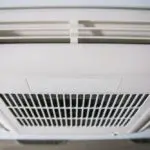How Does A RV Refrigerator Work While Boondocking?
RV fridges are designed to operate using one of three sources. They are either configured as Two-Way RV fridges operating on 110V AC from the grid or propane gas to provide the heat required to drive the chemical absorption process, as Three-Way fridges having the additional option of 12 V DC power supplied by a battery or operating strictly on a 12v compressor system.
Boondocking sites do not provide the option of connecting to the 110V AC grid and the RV fridge will be run on propane gas or from a 12V DC house battery. A propane gas flame or 12V heating element heats up a mixture of chemicals in the heat exchange system designed to cool the inside of the fridge.
The design of RV absorption refrigeration is different from household refrigeration where the moving components in the compressor unit are required to pump the cooled gas back into the liquid phase before it is released into the capillary network of pipes inside the fridge to cool down the interior as the liquefied refrigerant turns into a gas, which creates the cold. Let’s look at how the RV refrigeration system is designed to work.
How Does A RV Absorption Fridge Function On Electrical Power or Propane Gas?

In absorption refrigeration, heat is absorbed from the interior of the fridge. The absence of heat will result in the interior space being cold. There are no moving parts in an absorption refrigerator.
A sealed and pressurized system has a boiler that contains liquid water, ammonia, hydrogen gas, and sodium chromate and is heated by either a propane flame or an electrical heating element (AC and DC).
The cooling process is based on the laws of physics and chemistry. All four of the chemical compounds in the pressurized system make the fridge function properly. The sodium chromate prevents the aluminum-based system from corrosion.
As the heating element or propane flame heats the liquid in the boiler (generator), the ammonia and water will vaporize and rise in the tube as a gas.
Heat is required for the liquid to undergo a change in phase to form a gas. The hot gas consisting of steam and ammonia will rise up the pressurized system. The water will be the first to condense and flow back via an accumulator pipe.
The ammonia gas will travel into condenser tubes inside the fridge where it will condense back to a liquid, absorbing heat from inside the fridge.
As the liquid ammonia reforms in the condenser tubes, gravity will draw the liquid down into the accumulator to recombine with water and flow back into the boiler to start the cycle all over again.
The hydrogen gas in the system assists with the formation of ammonia in the liquid phase and the sodium chromate prevents the corrosion of the aluminum pipes comprising the sealed system.
The system is different from household refrigerators in that it does not have a motor that provides the pressure to condense the refrigerant gas. The system relies on the columns being perfectly perpendicular so that gravity will be most effective in pulling the liquid solution down to the heating reactor again.
Boondockers do not have the benefit of being able to connect to utilities like water, AC power, and sewerage as is available in most RV parks. Their RV fridges will thus have to work on either 12V DC or propane gas heating.
Is Residential Type Refrigeration For Boondocking Possible?
It is possible to run a residential refrigerator while boondocking. You will need either a generator to keep it going, or a combination of solar to charge a large battery bank and an inverter to make 120v power from your 12v battery bank. A generator can be used to charge your batteries on a cloudy day if you go this route.
The traditional absorption-type RV fridges are limited in size and cooling ability compared to residential-type 120v fridges and freezers.
Advances in battery and inverter technology for the yachting community has resulted in fridge/freezers that are run off AC power supplied from an inverter linked to a Li-ion battery bank able to store significantly more energy than the old deep cell marine batteries.
Absorption-type RV fridges did not work on yachts as they are required to remain stable and perpendicular to allow gravity to draw down the condensed liquid. Yachts are seldom level when underway and could thus not support the operational requirements of absorption fridges.
The demand for off-grid living has driven the development and lowered the cost of solar panels, wind generators, and fuel-powered generators to charge up modern Li-ion technology battery banks and provide power for all residential needs.
Modern houses, RVs, and boats can now be completely self-sufficient in power generation using renewable energy sources only.
Modern residential type fridges and freezers have also become much more energy-efficient due to improvements in insulating materials and compressor design.
The heating and cooling requirements in a house, boat or RV demand the most energy. The use of energy-efficient lights, fans, induction cooktops, air conditioners, and fridges has to be carefully considered and managed to prevent system overload.
Intelligent energy monitoring and management systems exist to help owners to manage their power generation, storage and consumption. The awareness of people living completely off-grid of their energy demands and pollution footprint is critical to their ability to enjoy the luxury of modern electrical devices.
12v Refrigerators and Boondocking
12-volt refrigerators have been becoming more common in the market today as they can cool down faster, provide better cooling, and can be used while you are driving. These are also larger due to less components and operate as a normal household fridge with a compressor.
The downside to these is that if you are boondocking, they will use only battery power to run and will eat through your battery bank unless you have a solar system to keep it charged.
Can You Run An RV Fridge While Driving?
RV Fridges designed to run off 120v AC or 12V DC power can be run while you are on the road. The safest and most convenient way to power the fridge would be to run it on the 12V DC system as you can keep charging this system using the RV engine alternator to generate power and charge the battery bank.
Using propane gas to generate the pilot flame needed to heat the RV fridge boiler whilst driving is not recommended. The risk of open propane gas lines whilst driving is too high. In case of vehicle accidents or undetected gas leaks, the risk to you and your family can be fatal.
Run the fridge off the 12V DC house battery bank and top up the energy if the house bank by charging it with solar panels or the engine alternator. Pack the empty spaces in the fridge with frozen ice packs and keep the door closed as much as possible to ease the cooling required from the absorption system.
Conclusion
Boondocking is often the only option available when RV parks are full or when connecting to AC power is not an option. RV absorption-type fridges have been designed to operate with three different sources of heating.
A propane gas flame or electrically heated element (12V DC or 110V AC) can percolate the chemical mixture in the system to create cooling inside the fridge.
Using a combination of 12V DC power and the propane gas will allow you to operate the fridge for about 12 hours when the connection to 110V AC is not available.
Care should be taken to manage the charge in the 12 V DC battery bank to prevent the system from draining too low as this will damage the battery. A solar array, fuel powered generator, or the alternator on the RVs engine can be used to charge the 12V batteries.
Be the first to be notified about FREE tips, hints, coupon codes, and email-exclusive information. All for FREE!













